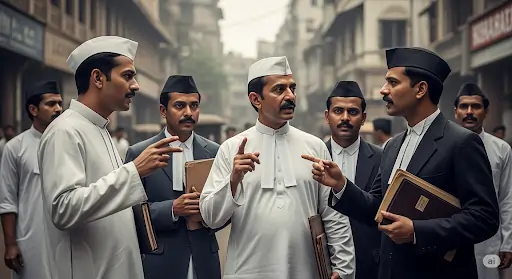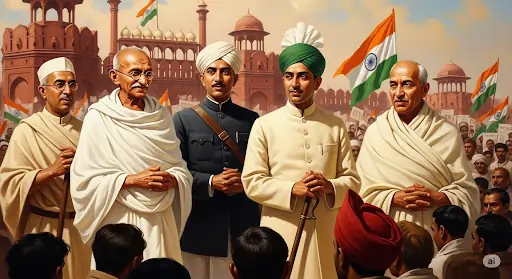
The Indian independence movement changed shape and form in many ways. Its leaders came from diverse social backgrounds, including lawyers. Their legal knowledge and experience made them aware of British oppression and inspired their calls for struggle. Five such revolutionary lawyers—B.R. Ambedkar, Mahatma Gandhi, Jawaharlal Nehru, Sardar Vallabhbhai Patel, and Bal Gangadhar Tilak—significantly influenced India’s path to independence.
1.Dr. Bhimrao Ramji Ambedkar (1891-1956)
B.R. Ambedkar is a famous jurist, author, and social reformer; a barrister trained at Gray’s Inn, London and Columbia University; and is the architect of the Constitution of India. However, this also means more than being an author and drafter of legal documents. Ambedkar’s revolutionary work was devoted to ending caste oppression, confronting the colonial state, and addressing capitalism. In his role as lawyer, he mediated for a few communities that would function outside any caste framework, and used his legal scholarship as leverage to strive for a more equitable socioeconomic spectrum. His work and participation from there, leading legal responses to colonial state violence and social inequity in the Mahad Satyagraha (1927) and Poona Pact (1932).
Ambedkar’s oratory and writings evidence and articulate the different Responding to mass indignation in his community and then live, exposing caste oppression and revolutionising India’s system of social, legal and economic order, Ambedkar’s military strategic in the warrant to create inter-institutional violence and oppressive systemic violence had extraordinary response inclusive of revolting masses support, once he was out in the field to defend the rights of the marginalised against state sanctioned violence.
2. Mahatma Gandhi (1869–1948)
Mahatma Gandhi, also known as Mohandas Karamchand Gandhi or the Father of the Nation, studied law at the Inner Temple in London to become a barrister. Then he went to South Africa to practice law; and only returned to India after all those years. While in India Gandhi developed Satyagraha (non-violent disobedience), which later became the basis of a struggle for India’s freedom. He returned from the years of petitioning and drafting negotiations with the British authorities (1915) and, from there was able to mobilize hundreds of millions of people, as leader of the Non-Cooperation Movement (1920-22), the leader of the Salt March (1930), and the quit India movement (1942). Gandhi translated ideas and rights into movements, and he mobilized people around the moral compass he provided. He became a revolutionary leader and was able to shift a transformative movement prior in history.
3. Jawaharlal Nehru (1889–1964)
Jawaharlal Nehru was the first Prime Minister of India and he had trained as a barrister at the Inner Temple in London. Nehru’s legal training focused his thoughts on India’s demands for independence and helped him to articulate demands for India’s independence internationally. Nehru undertook revolutionary activity by heading the radical branch of the Indian National Congress and joining in the Non-Cooperation and Civil Disobedience movement. Nehru’s speeches and other writings, for example, The Discovery of India, show legal skill in how he framed India’s requirements for self-rule. Nehru demonstrated his revolutionary credentials through his repeated imprisonments on behalf of India’s quest for independence and he promoted a vision of a secular and socialist India, as well as leading the Quit India Movement.
4. Sardar Vallabhbhai Patel (1875-1950)
Vallabhbhai Patel has become, of course, ‘The Iron Man of India’. Patel was a barrister who trained in London and established a law office in Ahmedabad, where his law office developed many of the plans of action and organizational abilities he deployed later for his contribution to the independence movement. Patel began to be distinguished as a significant leader during the Bardoli Satyagraha (1928), of farmers’ movements against unjust taxes which he led, doing so in a manner that warrant public adulation and elevation of Patel as in departing the “Sardar” of the farmers he led as part of this campaign.
It was the Sardar who would lead Congress, and with his training teach how to organize mass movements in order to confront British imperialism, and that the legal education he would contend against British colonial policies. Patel, when independence did arrive, played a major role in unifying the 562 princely states into the Indian Union, a task that was monumental in creating a sense of unity within the country, and was an exercise of revolutionary inspiration.
5. Bal Gangadhar Tilak (1856-1920)
Bal Gangadhar Tilak was known as “Lokmanya” meaning only “the one dear to the people.” His formal education culminated with his becoming a lawyer, and he attended the Government Law College, Bombay, India. Tilak was unremittingly committed to Swaraj (self-rule), and used his legal background to confront British rule through his political newspapers, which were Kesari, written in Marathi, and Maratha, written in English. His trial for sedition in 1897 along with a subsequent widely publicized second trial for sedition in 1908 represented both his defiance, and the upholding of a legal right to free speech in the court. Tiltak’s rallying, “Swaraj is my birthright, and I shall have it,” became a clarion call for millions. Tilak’s contributions to law and scholarship laid the groundwork for others to become India’s revolutionaries.
These five lawyer-revolutionaries gave their lives to the freedom of India while engaging with their legal careers. From Ambedkar, who opened the door to social justice, Gandhi who feminized the struggle with non-violent resistance, Nehru whom engaged with opinion on the international stage, Patel who sought to unify the new state, and Tilak who crystallized it with radical nationalism; they captured moments of discovery from the trip of justice.
